This guide will explain everything you need to know when buying a guitar slide from finding the right size to the type of material. I’ve even included a guitar slide sizing chart and instructions on how to measure your finger to find the right size guitar slide.
Once you find a guitar slide that suits you, find out How to Use a Guitar Slide here for a lesson with simple guitar slide exercises in Guitar TAB and diagrams.
Then you can learn some Easy Guitar Slide Songs here to get started playing with a guitar slide on some of the best guitar slide songs.
What is a Guitar Slide
A guitar slide is a metal, glass, or ceramic cylinder a guitarist places over a finger to glide up and down the guitar’s fretboard. A guitar slide creates a smooth and slippery sound well known in blues music.
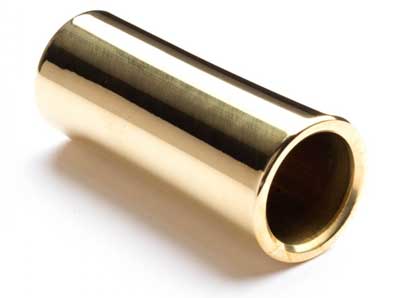
Guitar slides have been used for a very long time and they produce a distinctive sound. The good news is that they’re cheap to buy and fairly easy to learn.

In the above photo, you can see Derek Trucks (an incredible slide guitarist) use a glass guitar slide to slide back and forth between notes. This is what we mean when guitarists talk about slides.
There can be some confusion when somebody says ‘slide guitar’ because it can mean something other than what you see in the above photo.
The below photo shows a lap-steel guitar which some people call a ‘slide guitar’:

While the idea behind lap-steel guitars is very similar to using a guitar slide on a regular guitar, think of them as two very different instruments.
In this guide, we’re not talking about lap-steel guitars and only talking about playing a regular guitar with a guitar slide on a finger.
What Are Guitar Slides Made Of
Guitar slides are typically made of either steel, brass or glass but other materials such as ceramic or stone are available. The type of material used for the guitar slide determines the guitar tone.

While the above photo shows a wide range of different materials used in guitar slides, most guitarists use either a metal or glass slide.
Apart from weight and comfort, the main difference between different slide materials is the tone the slide creates.
How Guitar Slide Material Affects Tone
Guitar slides with more mass and higher density produce a brighter tone with more sustain.
For example, if you have a thick and heavy brass slide, it is going to have a lot of sustain and a bright sound if you compare it to a light glass slide.

It should be no surprise that two to guitar slides shown above will produce completely different tones.
Metal guitar slides create a more metallic and brighter tone while glass slides produce a more mellow and rounder tone. Ceramic slides fit somewhere between the two in terms of warmth and sustain.
There is no rule to say which type of slide is best or what you should use.
Some guitarists prefer metal guitar slides while others prefer glass slides. Many rock guitarists like using a metal slide for the tone they create, but there are rock guitarists who prefer glass slides.
If you are just getting started with guitar slides, I recommend buying a metal slide and a glass slide so you can figure out what is best for you.
How Do I Choose a Guitar Slide
There are four things you need to consider when choosing a guitar slide: fit, material, thickness, and length. The guitar slide needs to fit your finger properly and produce the right tone for what you’re playing.
Let’s look at how to choose a guitar slide that suits you:
Guitar Slide Fit
Guitar slides come in different sizes to fit different fingers. Some people have thin fingers while others have tree-stump-like fingers.
The proper fit for a guitar slide is when the slide is snug on your finger, but not tight. You should be able to easily remove it without any effort and it should not fall off of your finger.
If a guitar slide is too narrow, it won’t fit your finger. If you’ve ever put a ring on and couldn’t get it off, imagine what it would be like with a guitar slide.

You can see in the above photo that this guitar slide is too narrow for my middle finger. The same slide fits perfectly on my pinky as shown below:

If a guitar slide is too wide, it makes it hard to control while playing. A loose guitar slide gives you less precision over each note and can create unnecessary noise while playing.
A helpful guitar slide sizing chart is provided later to help you figure out what size slide is right for you.
Guitar Slide Material
As explained earlier, the material of the guitar slide plays a big role in the tone you hear.
A metal guitar slide will give you a brighter tone while a glass slide will give you a warmer tone. Ceramic slides fit somewhere between the two.
While it would be nice to give you a clear rule on what type of slide to use for each style of music, it isn’t that simple.
Every guitarist has different preferences when it comes to guitar slides, which is why there are so many different types.
Guitar Slide Thickness
The thickness of a guitar slide changes the weight of the slide, which impacts sustain. In other words, thickness plays a big part in a guitar slide’s sustain. A thick guitar slide will produce more sustain than a thin guitar slide.
For some guitarists, more sustain is better as it allows you to play long gliding notes.
If you like the idea of playing violin-like notes like what you hear in the slide section of All Along The Watchtower by Jimi Hendrix (find out more about this song here), then you may prefer a guitar slide with more sustain.
For other guitarists, sustain when using a slide isn’t important. If you want to play fast and furious licks with your slide, having a thicker slide isn’t important. In fact, you may prefer a light slide so you can effortlessly jump around the fretboard.
The right guitar slide thickness for you depends on the material you are using and the style of music you want to play.
Guitar Slide Length
As explained earlier, guitar slides come in two different lengths. You can either get a full-length slide that fits over all of your strings at once, or you can get a partial-slide that only covers a couple of strings.
Most guitarists will prefer a full-length guitar slide, but keep this choice in mind.

You may find that a partial guitar slide suits your playing style better as it gives you greater freedom over the fretboard when you want to play normal guitar parts. I’ll go into the differences between the two later in this guide.
How To Measure Your Finger For a Guitar Slide
It is important that a guitar slide properly fits your finger. If it is too loose, it will be hard to control. If it is too tight, it may not fit at all or it may get stuck on your finger.
To properly fit a guitar slide, you need to measure your finger. follow the below instructions for different ways you can accurately measure your finger for a guitar slide.
Once you know your finger’s ring size, you’ll be able to match it against any slide you buy.
Important: the weather can make a difference in your measurements. Hot weather will make your fingers swell up slightly. This means if you measure your finger in the middle of winter and find a guitar slide that fits snug, don’t be surprised if it feels a bit tight during summer.
Method 1: Local Jeweler
Going to a local jeweler is the easiest way to accurately get your ring size.
Simply ask to have your finger measured and they will use their own devices to give you an accurate measurement.
You want the slide to easily slide on or off your finger, so make sure the test ring they put on your does the same.
Rings tend to be quite snug on a finger, which is too tight for a guitar slide. Once they tell you your ring size, ask to try something on the next size up and see how easily it comes off of your finger.
I have a guitar slide the exact same size as my ring and it is significantly harder to take off than my ring. Give your finger a bit of room and aim for a slightly larger size than what your ring size says.
Method 2: Tape Measure
There are a couple of different ways you can measure your ring size on your own.
If you have a flexible measuring tape, that’s as easy as it gets. Simply wrap it around the widest point on your finger to measure it as shown below:


Check your measurement against the guitar slide sizing chart below to find your ring size.
If you don’t have a flexible measuring tape, you can use string, a strip of paper, or anything else flexible enough to wrap around your finger.
Here is an example of how to use a strip of paper to measure your finger:


Cut a length of paper and wrap it around your finger. Use a pen or pencil to mark out where the paper overlaps your finger. Then measure the length of paper using a ruler.
You can see that this method gave almost the same result as using a flexible tape measure. Your measurements will vary depending on how tight you wrap it around your finger.
Method 3: Wrenches
If you have a set of wrenches, they give you a quick and easy way to measure your ring size.


I recommend using the open end of the wrench to avoid getting your finger stuck in the closed end.
Simply hold your finger against the wrench and work your way through the wrenches until you find the one that gives you a slight clearance between the sides as shown below:


You should be able to easily slide the wrench along your finger without any resistance but not so easily that it barely touches your finger.
If you think you’ve found the right sized wrench, flip it over and see how the closed-end fits your finger. This gives you a great indication of what a guitar slide this size will feel like.


Once you have found the right size wrench, check the wrench size and compare the size with the sizing chart below. The above wrench felt exactly the same as the guitar slide I use, so this is a good method to use if you have a wrench set handy.
Method 4: Local Guitar Shop
A foolproof method of finding the right size guitar slide for you is to go to your local guitar shop and try a few out. Most guitar shops will have at least a few guitar slides available to test out, so try a few different sizes and see what fits.
Unless you know for sure which finger you want to use for the slide, find out the ring size on all four fingers of your hand.
If you know the ring size of all your fingers, you can buy something that works across different fingers.
For example, I have a thin slide that only fits on my pinky and a wider slide that works on the other three fingers. With those two slides, I can change between different styles of playing and can play slide on any finger I want.
Guitar Slide Sizing Chart
Use the below guitar slide sizing chart to find your finger’s ring size. I recommend measuring your finger in millimetres (mm) as it will give you a more precise reading. If you have measured your finger in inches, use Google to convert it to millimetres.
Guitar slides are measured in ring sizes, so the below chart will allow you to buy guitar slides online without having to test them out first.
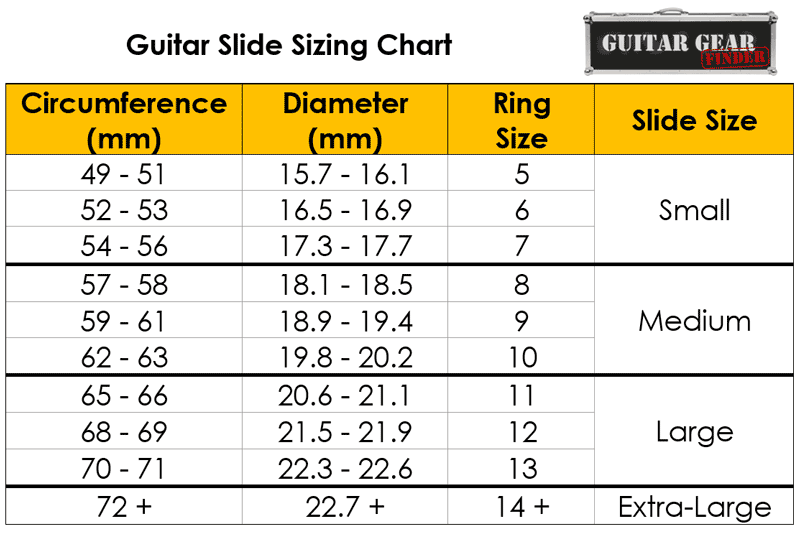

For example, in the earlier photos, you could see that I measured my ring finger’s circumference to be around 68-70mm. By looking at the above sizing chart, this means that the finger has a ring size of either 12 or 13, which means I need a large slide for that finger. When using the wrench method, the diameter of the wrench was 21mm, which matches a ring size of 12.
When I measure my pinky’s circumference, it measures 60mm, which gives me a size 9 ring, which is a medium-size slide. As I mentioned above, measure each finger to see whether you can use the same size slide on all fingers or whether you might need to get a different size for different fingers.
How Long Should a Guitar Slide Be
There two options on the length of a guitar slide. You can get a guitar slide long enough to cover all strings on your guitar, or you can get one that only covers a couple of strings at once.
The length of the guitar slide you use with play a big part in the type of things you can play so let’s look at the main differences between the two options.
Full-length Guitar Slides
The most popular option is to get a guitar slide that is long enough to cover all strings on your guitar at once. It should be long enough that it rests against all strings, but not longer that it sticks out over the fretboard.
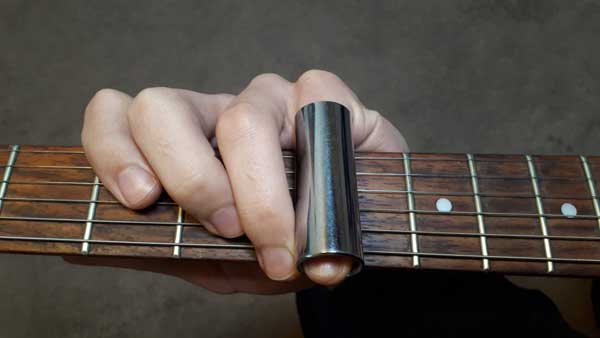

In the above photo, you can see that the guitar slide is long enough to cover all six strings on the guitar at the same time.
Having a full-length guitar slide gives you the best range in what you can play with the slide. You can play single notes or you can play anything all the way up to full chords with the slide.
The downside of a full-length guitar slide is that it restricts the finger and limits any ‘normal’ guitar parts you may want to play. Depending on the style of music you play, this may or may not be an issue.
As explained in this lesson on how to use a guitar slide, the finger you place your guitar slide on plays a big part in what normal guitar parts you can play.
If you get a full-length guitar slide, I highly recommend reading the lesson to figure out which finger is best for your style of playing.
Partial Guitar Slides
The other option is to use a partial-slide that only covers a few strings at a time. Partial slides are far less common than full-length slides, but they do suit some guitarists.
Some guitarists prefer partial slides because they feel they’re more comfortable to play and give you more control over what you’re playing.
For example, if the slide licks you play only use one or two strings at a time, with a partial slide you simply line the slide up to cover those strings.
Instead of having a long guitar slide restings on strings you won’t play, the partial slide only rests on what you want it to rest on.
The other possible advantage of partial guitar slides is that you may be able to play guitar normally while the slide is still on your finger.
In the below photo, you can see that I can still play guitar normally while a partial slide sits on my finger:
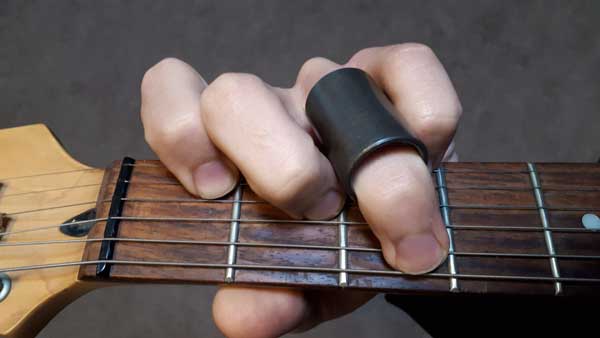

This means I can easily switch between normal playing and slide playing. There are even reversible guitar slides that you can flip around to switch between slide playing and normal playing.
Depending on the style of music you play, a partial slide may suit you. If you’re used to playing a normal full-length guitar slide, it will feel awkward at first.
Best Guitar Slides
There are a lot of different types of guitar slides and every guitarist has different tastes on what they want from a guitar slide.
Once you know what size guitar slide you need to get (as explained above), the main choice to make is what material you want to use.
Have a look through the different options below for some of the best guitar slides available.
Unlike guitars or guitar pedals, there isn’t much difference between a cheap and an expensive guitar slide in terms of quality.
I recommend buying a few different types of guitar slides so you can figure out what type of slide suits you best. At the very least, get yourself a metal slide and a glass slide so you can compare them for yourself.
Glass Guitar Slides
Glass guitar slides create a mellow tone and are commonly thought of as ‘smoother’ to play. They’re lighter than metal slides, which is great if you want to play fast licks.
While glass guitar slides are typically made with tempered glass, they can break if you drop them on a hard surface. If you’re rough with your gear, keep this in mind.
There are two basic types of glass guitar slides you can get: straight or bottle. Straight glass guitar slides are simple to use and come in a variety of thicknesses.
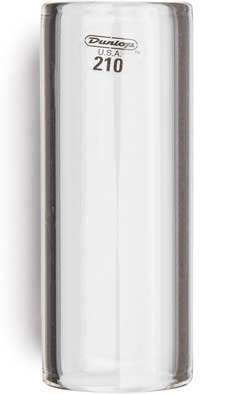

The Dunlop range of glass guitar slides (link to Amazon) are popular and cover a variety of different sizes. For example, the Dunlop 210 is a medium-thickness glass guitar slide suitable for ring size 11.
There are even partial glass slides if you want if you like the idea of having more freedom for normal guitar playing.
The other option is to get a bottle-style glass guitar slide like this:


These are incredibly popular despite being a weird thing to place on your finger. In the early days of slide playing, guitarists would make their own slides out of bottles. The tradition continues with purpose-made bottles with straight walls to use as guitar slides.
As long as you hold these correctly, they’re just as easy to play as regular slides. Keep the lip of the bottle off of the strings to avoid bumping into the frets.
Check out the different sizes and styles of bottle guitar slides here (link to Amazon).
Brass Guitar Slides
Brass is a heavy metal and can produce some fat tones. A thick-walled brass guitar slide can provide some impressive sustain. Thin brass slides are also available if you don’t want the extra sustain or weight.


The above Fender brass guitar slide is an example of a thick-walled slide that provides a lot of sustain. I use a thick brass slide like it and it gives a very distinctive tone.
An extra benefit of brass is that manufacturers are able to create concave slides like the one shown below:
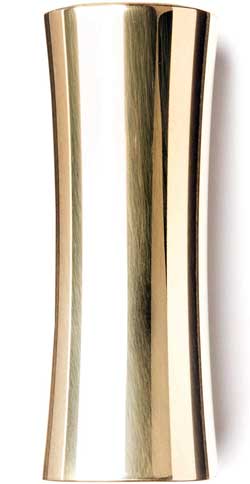

The idea behind these slides is that they fit nicely over the guitar’s radius. I’ve only tried one for a short time, but it was noticeable how it seemed to grab onto the strings and hold in place.
Some guitarists love this while others prefer the way straight guitar slides freely move over the strings.
Check out the Dunlop 227 for an example of a popular concave brass guitar slide.
Chrome Steel Guitar Slides
An alternative to brass is chromed steel. Steel guitar slides provide a similar tone as brass but tend to come with thinner walls.
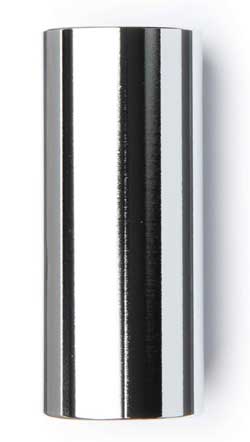

The Dunlop 220 is a very popular chrome steel guitar slide with pretty thin walls. The thin walls give you a lighter slide while still providing the tone you would expect with a metal slide.
Chrome-plated brass slides are also available, which give a very similar tone.
Tip: Be aware that if you search for steel guitar slides, you will likely see a lot of slides meant for lap steel guitars. Sometimes it can be hard to tell from a photo, but many of the listings you will see are actually ‘tone bars’ designed for lap steel guitars and will not sit on your finger like a normal guitar slide.
Reversible Guitar Slides
The below guitar slide is a ‘reversible’ guitar slide:


The idea behind these guitar slides is that you can rotate it around your finger to alternate between slide playing and normal playing.
The slide can be rotated one-handed using your thumb, so you are able to quickly switch it back and forth between the two positions. Whether this is easier than taking a slide on and off of your finger is something I haven’t had the opportunity to test out.
Check out this Shubb Axyx reversible guitar slide here.
Partial Guitar Slides
Most of the slides in this guide are designed to cover all of your strings at the same time. This is great when you want to play in an open tuning as it allows you to play full chords using the slide. Find out about open tunings in this guide.
But in many cases, you’re unlikely to play more than two strings at a time with a guitar slide. If you only play single-notes or two-notes at-a-time with the slide, then having a full-length slide can be overkill.
Partial guitar slides are shorter than normal slides and only cover a few strings at a time.



These types of slides require more control but give you the ability to use the finger with the slide on it. As I showed earlier, I am able to use all four fingers when playing with a partial slide.
This is great if you regularly alternate between normal guitar playing and slide guitar playing. Having a shorter slide gives your finger more flexibility to play normal guitar parts.
Partial guitar slides are available in glass, brass, chrome steel, or ceramic, so you have plenty of freedom to choose on that suits you.
Check out some short/stubby guitar slides here for examples of different length slides (link to Amazon).
An alternative to consider is a ‘ring’ guitar slide as shown below:


These slides are very short so they would only suit guitarists who play simple one-note-at-a-time licks with a slide. They’re more suited to guitarists who play mostly regular guitar parts but like to throw in some slide effects or licks on occasion.
Check out the Will Ray Stealth Slide Ring here.
Ceramic Guitar Slides
Ceramic guitar slides sit somewhere between glass and metal in terms of tone. Glass and metal guitar slides produce significantly different tones, so a ceramic guitar slide is a good middle-ground tone if you’re looking for something a bit different.
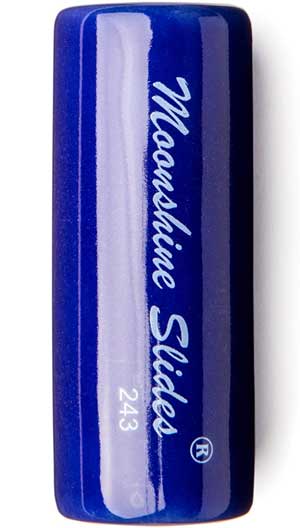

The above slide is a Dunlop 243 Moonshine ceramic guitar slide and is one of the most popular ceramic guitar slides.
A benefit of ceramic is that they’re easy to print designs on them, so there are a lot of unique looking slides available. There are many different signature models with designs that look a bit more interesting than a plain glass or metal slide.
Check out these ceramic guitar slides for examples of different signature models and designs.
If you’re looking for something a bit different, check out ceramic slides.
Homemade Guitar Slides
Over the years guitarists have used a wide range of objects as guitar slides. While the most popular option is to use a glass bottle, other items can be used that you may already have at home.
Here is a list of items that can be used as a guitar slide:
- Lighters
- Bottles
- Batteries
- Microphone or mic stand
- Whammy bar
- Lipstick
As you might expect, the tone produced by these objects will vary dramatically. A plastic lighter will sound very different than a metal Zippo lighter or microphone.
There is another option if you like the idea of using a glass bottle as a slide. You can buy a glass cutter to make your own guitar slide out of any glass bottle.


This bottle cutter kit has everything you need to create your own guitar slides from any glass bottle.
A clamp-like device sits over the bottle and lets you cut the neck at any length you want. Then you use a contoured abrasive stone to smooth the edges of the glass to make it safe to touch.
Depending on the size of your fingers, you may find that you have an unlimited range of different bottles you can use as guitar slides.
Be careful if you decide to try this out. Make sure you properly cut and prepare the glass to avoid cutting yourself. If you don’t properly sand the edges down, you can easily slice your finger open.
It’s also important to note that the glass used in bottles isn’t tempered, so it is significantly weaker than a glass guitar slide. When you cut the bottle, it weakens the glass, so don’t be surprised if these bottle slides are easy to break. The good news is that they’re easy to replace once you have the cutting tool.
How to Play Slide Guitar
Now that you know all about guitar slides, you can start using one.
This Guitar Slide Lesson will teach you:
- Which finger to place your guitar slide on depending on your playing style
- Simple guitar slide exercises to develop your guitar slide skills
- Tips and tricks to get the most out of your guitar slide
If you’re just getting started with a guitar slide, I highly recommend working on the exercises in the lesson.
Once you develop some basic skills from the lesson, you can start looking at playing songs that use a guitar slide.
Check out this Guide to Easy Guitar Slide Songs to learn some well-known and fun to play guitar slide songs.
The songs covered in that guide are a great starting point as they sound great to play but aren’t as difficult as other popular guitar slide songs.
Some of the songs are in standard tuning and some are in alternate tunings, so you’ll get to see how changing your guitar’s tuning can open up new ways of playing a guitar slide. Check out this Guide to Alternate Tunings for a list of open tunings and other tunings that work well with guitar slides.
Give the songs a go and subscribe here for email updates whenever I write new lessons or guides like this one.
